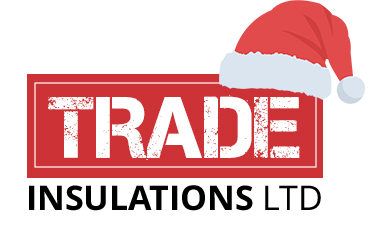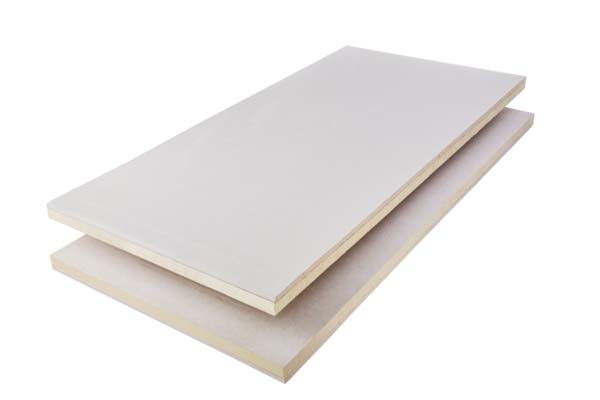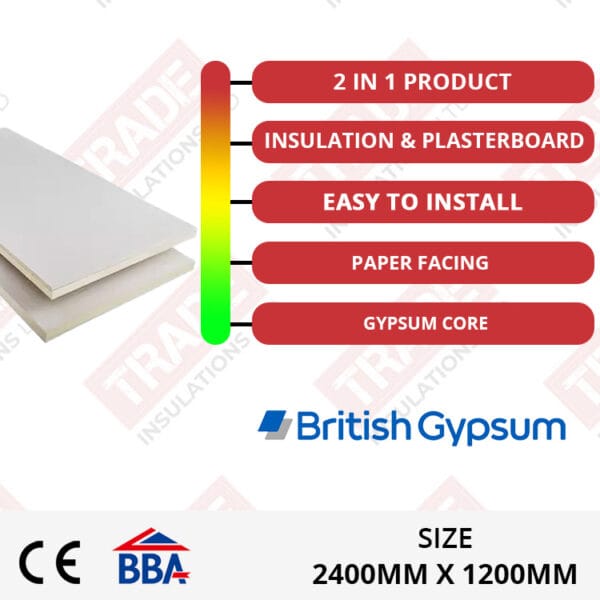Gyproc Thermaline PIR Insulated Plasterboard
British Gypsum Gyproc Thermaline PIR is an insulated plasterboard material designed to be applied to walls and ceilings to complete the area whilst improving the thermal performance of the building. This product is made up of a 12.5mm gypsum plasterboard bonded to a polyisocyanurate (PIR) core including a vapour control layer with multi-layer kraft aluminium facings on each side of the foam board. Thermaline reduces the risk of condensation and reduces heat escaping from the building.
Showing all 5 results
The boards can be cut by measuring to size and cut with a plasterboard saw. Holes for sockets etc can be cut with a utility saw. Protective gear is recommended when using Gyproc Thermaline boards, due to the dust produced when cutting the materials. This includes gloves, eye protection goggles, protective clothing, and gloves.
Thermaline insulated plasterboards should be stored in a dry environment, on a flat surface. If indoor storage is not an option, ensure the boards are covered with the correct weatherproofing materials. Avoid putting heavy waits on the boards, although they are rigid, they can crumble from the inside. If boards are made wet, do not use. This product can be recycled providing it has not been contaminated by non-gypsum materials.
Thermaline PIR boards can be installed in a range of methods. These methods include:
- Wall and ceiling applications
- Loft space conversions
- Metal and timber frame applications
- Garage conversion applications
Please see below our Gyproc Thermaline PIR datasheet and safety regulations.
Safety Certifications:
- EN 13950:2014
- BBA: 13/5016
- Reaction to fire: B-s1, d0
- BS EN 13501-1
- BES 6001 classification: Excellent
- ISO 9001 Quality Management
- ISO 45001 Occupational Health and Safety Management
- ISO14001 Environmental Management
- ISO 50001 Energy Management
More Information:
Length: 2400mm
Width: 1200mm
Thicknesses: 38mm, 53mm, 63mm, 78mm, 93mm,
Thermal Conductivity: 0.022W/mK, 0.19W/mK
Material: Polyisocyanurate (PIR), Aluminium Paper
Colour: Ivory, Yellow
| Thickness (mm) | Thermal Conductivity (W/mk) | Thermal Resistance (m2k/W) | Length (mm) | Width (mm) |
| 12.5 + 25.5 | 0.19, 0.022 | 1.15 | 2400 | 1200 |
| 12.5 + 40.5 | 0.19, 0.022 | 1.85 | 2400 | 1200 |
| 12.5 + 50.5 | 0.19, 0.022 | 2.30 | 2400 | 1200 |
| 12.5 + 65.5 | 0.19, 0.022 | 3.00 | 2400 | 1200 |
| 12.5 + 80.5 | 0.19, 0.022 | 3.65 | 2400 | 1200 |
Installation guide:
Measure the relevant space and cut the insulated plasterboards to size if necessary. Fix the boards into place using the required fixings with the plasterboard decorative side facing outwards from the wall. Install the fixing a minimum of 13mm from cut edges and 10mm from bound edges. Wherever possible place the cut edges at internal angles.
After fixing the board into place, start jointing as soon as you can. This will reduce the risk of damage or UV degradation to the paper liner. Scrim tape can be applied where boards are butted to prevent the boards from crumbling at the edges when plastering. Corner beads can also be fitted to the wall corners to protect from damage. You can finish the board using jointing systems that comply with EN13963, including the Gyproc range.
After fixing and jointing the board, continue onto finishing as soon as you can to limit the risk of damage or UV degradation to the paper liner. You can finish the board using plaster that complies with EN13279-1, including the Thistle range.
When the finishing system is dry, start to decorate as soon as possible. Finish jointing systems with Gyproc Drywall Primer before painting.
Decoration should start as soon as practicable after the finishing system is dry. Jointing systems should be finished with Gyproc Drywall Sealer before application of wallcoverings.
For minor damage and dents, check that the core of the board is not shattered. If it's intact, the area can be filled with Gyproc Easefully 60. Allow the filler to set and then go on to apply a second coat if necessary. When the filler is dry, light sand over it until smooth and flush before redecorating the area.
For a damaged core, broken edges or extensive damage, repair and replacement procedures differ depending on the number of board layers. Consult a professional builder if unsure about installing insulation materials.



